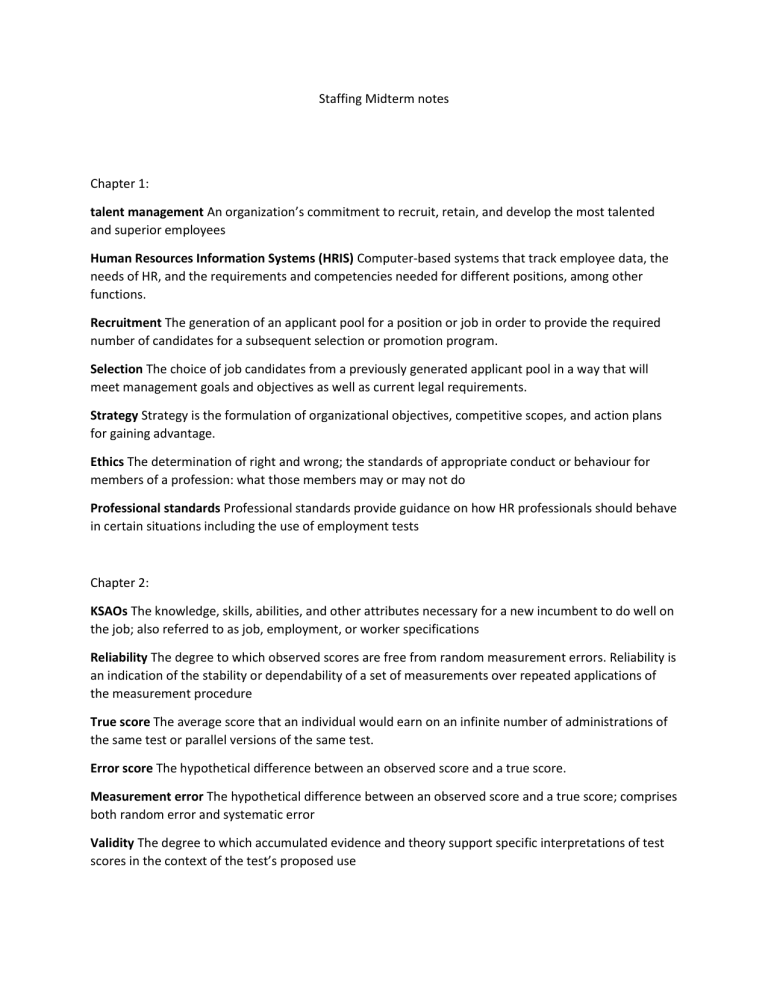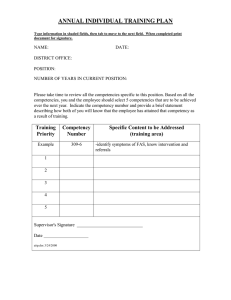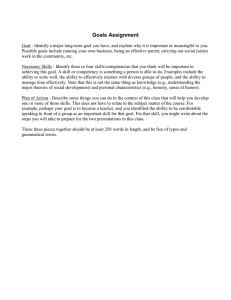
Staffing Midterm notes Chapter 1: talent management An organization’s commitment to recruit, retain, and develop the most talented and superior employees Human Resources Information Systems (HRIS) Computer-based systems that track employee data, the needs of HR, and the requirements and competencies needed for different positions, among other functions. Recruitment The generation of an applicant pool for a position or job in order to provide the required number of candidates for a subsequent selection or promotion program. Selection The choice of job candidates from a previously generated applicant pool in a way that will meet management goals and objectives as well as current legal requirements. Strategy Strategy is the formulation of organizational objectives, competitive scopes, and action plans for gaining advantage. Ethics The determination of right and wrong; the standards of appropriate conduct or behaviour for members of a profession: what those members may or may not do Professional standards Professional standards provide guidance on how HR professionals should behave in certain situations including the use of employment tests Chapter 2: KSAOs The knowledge, skills, abilities, and other attributes necessary for a new incumbent to do well on the job; also referred to as job, employment, or worker specifications Reliability The degree to which observed scores are free from random measurement errors. Reliability is an indication of the stability or dependability of a set of measurements over repeated applications of the measurement procedure True score The average score that an individual would earn on an infinite number of administrations of the same test or parallel versions of the same test. Error score The hypothetical difference between an observed score and a true score. Measurement error The hypothetical difference between an observed score and a true score; comprises both random error and systematic error Validity The degree to which accumulated evidence and theory support specific interpretations of test scores in the context of the test’s proposed use Content validity Whether the items on a test appear to match the content or subject matter they are intended to assess; assessed through the judgments of experts in the subject area. Construct validity The degree to which a test or procedure assesses an underlying theoretical construct it is supposed to measure; assessed through multiple sources of evidence showing that it measures what it purports to measure and not other constructs. For example, an IQ test must measure intelligence and not personality. Criterion-related validity The relationship between a predictor (test score) and an outcome measure; assessed by obtaining the correlation between the predictor and outcome scores Face validity The degree to which the test takers (not subject matter experts) view the content of a test or test items as relevant to the context in which the test is being administered Predictive validation Strategies in which evidence is obtained about a correlation between predictor scores that are obtained before an applicant is hired and criterion scores that are obtained at a later time, usually after an applicant is employed Concurrent validation Strategies in which evidence is obtained about a correlation between predictor and criteria scores from information that is collected at approximately the same time from a specific group of workers Validity generalization The application of validity evidence, obtained through meta-analysis of data obtained from many situations, to other situations that are similar to those on which the meta-analysis is based Bias Systematic errors in measurement, or inferences made from those measurements, that are related to different identifiable group membership characteristics such as age, sex, or race Fairness The principle that every test taker should be assessed in an equitable manner Chapter 3: Discrimination: In employment, any refusal to employ or to continue to employ any person, or to adversely affect any current employee, on the basis of that individual’s membership in a protected group. All Canadian jurisdictions prohibit discrimination at least on the basis of race or colour, religion or creed, age, sex, marital status, and physical or mental disability Employment equity: The elimination of discriminatory practices that prevent the entry or retention of members from designated groups in the workplace, and the elimination of unequal treatment in the workplace related to membership in a designated group Adverse effect discrimination: Refers to a situation where an employer, in good faith, adopts a policy or practice that has an unintended, negative impact on members of a protected group. Adverse impact: Occurs when the selection rate for a protected group is lower than that for the relevant comparison group Bona fide occupational requirement (BFOR): A procedure used to defend a discriminatory employment practice or policy on the grounds that the policy or practice was adopted in an honest and goodfaith belief that it was reasonably necessary to assure the efficient and economical performance of the job without endangering employees or the general public. BFORs are sometimes referred to as bona fide occupational qualifications (BFOQs) Accommodation: The three-part Meiorin test is now the standard under which all workplace practices, including selection testing, constitute bona fide occupational requirements. It is the test that courts, tribunals, and arbitrators use in determining whether a workplace practice can be considered to be a BFOR when considering whether those practices constitute either adverse or direct discrimination against individuals or groups. Sufficient risk: As part of a BFOR defence, an employer may argue that an occupational requirement that discriminates against a protected group is reasonably necessary to ensure that work will be performed successfully and in a manner that will not pose harm or danger to employees or the public Outreach recruiting A recruitment practice where the employing organization makes a determined and persistent effort to make potential job applicants, including designated group members, aware of available positions within the employing organization Chapter 4: Job analysis: is a method that provides a description of the job and profiles the characteristics or competencies people need to have in order to be successful in the job 1. A job analysis does not refer to a single methodology but rather to a range of techniques. 2. A job analysis is a formal, structured process carried out under a set of guidelines established in advance. 3. A job analysis breaks down a job into its constituent parts, rather than looking at the job as a whole Job description: A written description of what job occupants are required to do, how they are supposed to do it, and the rationale for any required job procedures. Job specification: The knowledge, skills, abilities, and other attriibutes or competencies that are needed by a job incumbent to perform well on the job Job: A collection of positions that are similar in their significant duties. Position: A collection of duties assigned to individuals in an organization at a given time Job family: A set of different, but related, jobs that rely on the same set of KSAOs Subject-matter experts (SMEs): People who are most knowledgeable about a job and how it is currently performed; generally job incumbents and their supervisors Work-oriented job analysis: Job analysis techniques that emphasize work outcomes and descriptions of the various tasks performed to accomplish those outcomes Worker-oriented job analysis: Job analysis techniques that emphasize general aspects of jobs, describing perceptual, interpersonal, sensory, cognitive, and physical activities Task statement: A discrete sentence containing one action verb that concisely describes a single observable activity performed by a job incumbent. Knowledge: A body of information, usually of a factual or procedural nature, that makes for successful performance of a task. Skill: An individual’s level of proficiency or competency in performing a specific task. Level of competency is typically expressed in numerical terms. Ability: A more general, enduring trait, or capability an individual possesses at the time he first begins to perform a task. Task inventories: Work-oriented surveys that break down jobs into their component tasks Worker traits inventories: Methods used to infer employee specifications from job analysis data. Competencies: Groups of related behaviours or attributes that are needed for successful job performance in an organization Competency model: A collection of competencies that are relevant to performance in a particular job, job family, or functional area. Competency framework: A broad framework for integrating, organizing, and aligning various competency models that are based on an organization’s strategy and vision Core competencies: Characteristics that every member of an organization, regardless of position, function, job, or level of responsibility within the organization, is expected to possess. Functional competencies: Characteristics shared by different positions within an organization (i.e., a group of related or similar jobs). Only those members of an organization in these positions are expected to possess these competencies. Job-specific competencies: Characteristics that apply only to specific positions within the organization. Only those people in the position are expected to possess these competencies Competency dictionary: A listing of all of the competencies required by an organization to achieve its mandate, along with the proficiency level required to perform successfully in different functional groups or positions. Proficiency level: The level at which competency must be performed to ensure success in a given functional group or position Proficiency scales: A series of behavioural indicators expected at specific levels of a competency Competency profile: A set of proficiency ratings related to a function, job, or employee Chapter 5: Job performance: Behaviour (the observable things people do) that is relevant to accomplishing the goals of an organization. Criteria: Measures of job performance that attempt to capture individual differences among employees with respect to job-related behaviours Task performance: Duties related to the direct production of goods and services and to the direct contribution to the efficient functioning of the organization that form part of a job. These duties are part of the worker’s formal job description. Contextual performance: The activities or behaviours that are not part of a worker’s formal job description but that remain important for organizational effectiveness. Adaptive performance: A worker’s behavioural reactions to changes in a work system or work role Counterproductive work behaviours: Voluntary behaviours that violate significant organizational norms and in so doing threaten the well-being of an organization, its members, or both. Job performance domain: The set of job performance dimensions (i.e., behaviours) that is relevant to the goals of the organization, or the unit, in which a person works Performance dimensions: Sets of related behaviours that are derived from an organization’s goals and linked to successful job performance Criterion relevance: The degree to which the criterion measure captures behaviours or competencies that constitute job performance. Criterion deficiency: Those job performance behaviours or competencies that are not measured by the criterion. Criterion contamination: The degree to which the criterion measure is influenced by, or measures, behaviours or competencies that are not part of job performance. Practicality: The degree to which a criterion measure is available, plausible, and acceptable to organizational decision makers Ultimate criterion: The concept that a single criterion measure reflects overall job success. Objective performance measures: Production, sales, and personnel data used in assessing individual job performance. Subjective performance measures: Ratings or rankings made by supervisors, peers, or others that are used in assessing individual job performance Relative rating system: A subjective measurement system that compares the overall performance of one employee to that of others to establish a rank order of employee performance. Absolute rating systems: Compare the performance of one worker with an absolute standard of performance; can be used to assess performance on one dimension or to provide an overall assessment.


